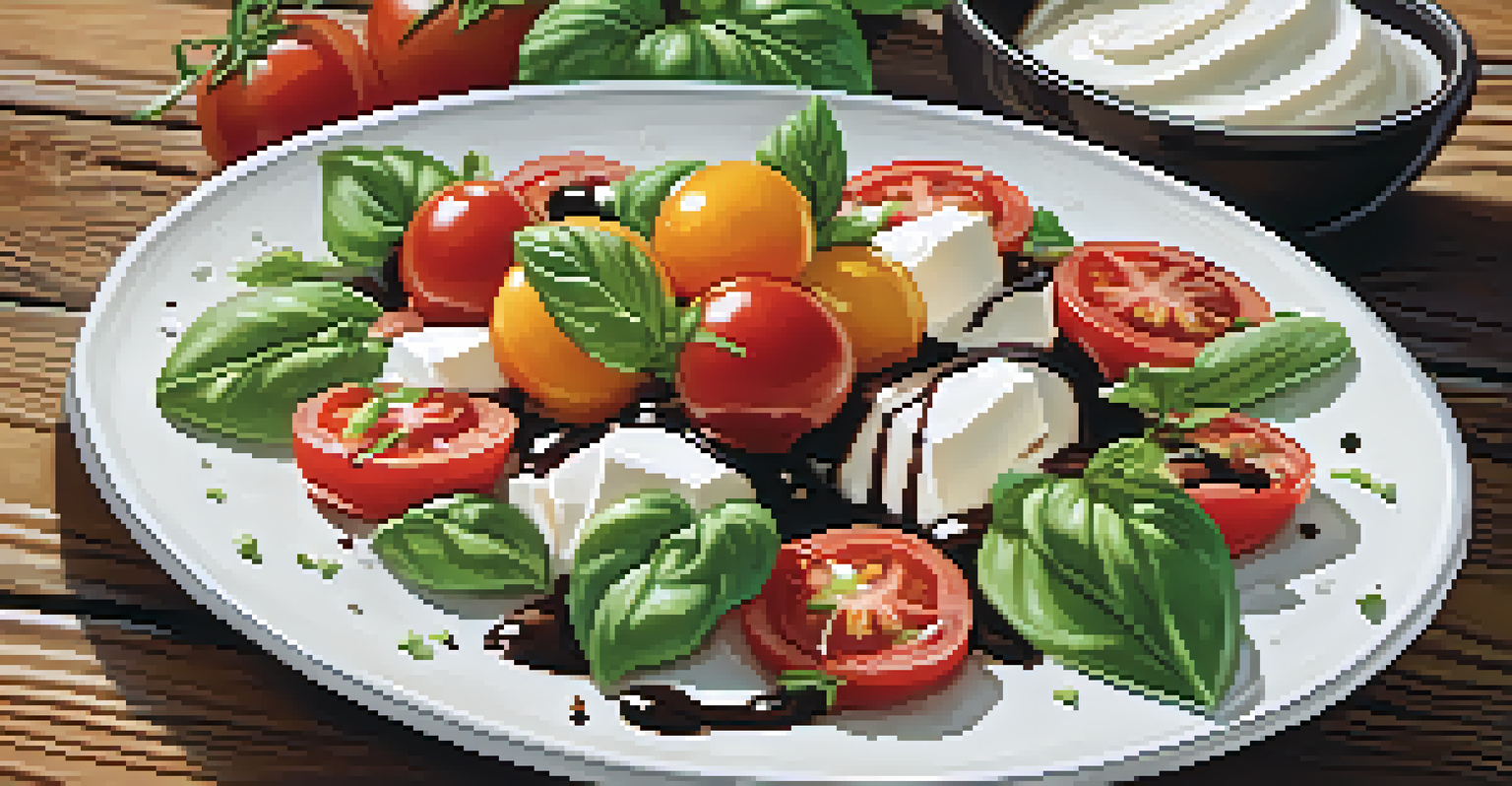Incorporating Seasonal Ingredients in Your Recipes

Understanding the Benefits of Seasonal Ingredients
Cooking with seasonal ingredients not only supports local farmers but also enhances flavor and freshness. When produce is in season, it’s harvested at its peak, resulting in more vibrant colors and richer tastes. For example, strawberries in June burst with sweetness, while those in winter often lack flavor and texture.
The best way to make your food taste better is to use fresh, seasonal ingredients.
Moreover, seasonal ingredients are often more affordable because they are plentiful. This means you can enjoy high-quality produce without breaking the bank. Think of how much more satisfying it is to bite into a juicy, ripe peach in summer than a mealy one in February.
Incorporating these ingredients into your meals can also inspire creativity in the kitchen. Each season brings a new array of flavors and textures, pushing you to experiment with recipes that highlight these unique offerings.
How to Identify Seasonal Ingredients
Identifying seasonal ingredients can be as simple as visiting your local farmer’s market. These markets typically feature produce that is in season, and many vendors are happy to share tips on how to cook with their fresh offerings. You might be surprised to discover a new vegetable or fruit that you’ve never tried before!

Another great resource is online seasonal produce calendars, which outline what’s in season by region. This can help you plan your meals around the freshest ingredients available. For example, in the fall, you might find squash, apples, and Brussels sprouts are at their best.
Benefits of Seasonal Ingredients
Cooking with seasonal ingredients enhances flavor, supports local farmers, and can be more affordable.
Don’t forget to pay attention to your own garden or local community gardens, if available. Growing your own herbs and vegetables can offer a hands-on way to learn about seasonality and what grows best in your area.
Incorporating Seasonal Ingredients in Everyday Meals
Incorporating seasonal ingredients into your everyday meals can be both fun and easy. Start by planning your meals around what’s currently in season, using these ingredients as the star of your dishes. For instance, a summer salad featuring ripe tomatoes and fresh basil can be a refreshing main course.
Eating seasonally means connecting with the rhythms of nature, and embracing the flavors that each season has to offer.
Consider adding a seasonal twist to your favorite recipes. If you love a classic pasta dish, try swapping out winter vegetables for spring peas or asparagus. This not only keeps your meals interesting but also takes advantage of the flavors that each season offers.
Even breakfast can benefit from seasonal produce! Think of adding sliced peaches to your morning yogurt in summer or using pumpkin puree in your oatmeal come fall.
Preserving Seasonal Ingredients for Later Use
One of the joys of seasonal cooking is the ability to preserve ingredients for later enjoyment. Canning, freezing, and drying fruits and vegetables can extend their shelf life, allowing you to savor the taste of summer in the middle of winter. For example, making homemade tomato sauce in late summer can provide a delicious base for meals all year round.
Herbs are also easy to preserve. Try drying or freezing them in ice cube trays with a bit of olive oil. This way, you can add a burst of flavor to your dishes any time you need it.
Identifying Seasonal Produce
Visiting farmers' markets and using online seasonal calendars can help you discover fresh, in-season ingredients.
Incorporating these preserved items into your cooking will help you connect with the seasons, even when they’re behind you. It’s like holding onto a little piece of summer or fall to brighten up your winter dishes.
Creative Ways to Use Seasonal Ingredients
Get creative with seasonal ingredients by experimenting with various cooking methods. Roasting root vegetables brings out their natural sweetness, while grilling summer squash adds a smoky flavor. You might even try pickling seasonal veggies for an exciting tangy addition to sandwiches and salads.
Don’t shy away from incorporating seasonal ingredients into unexpected places. Think about adding fresh herbs to your baked goods or using seasonal fruits in savory sauces. A peach salsa can perfectly complement grilled chicken, showcasing the versatility of these ingredients.
Another fun idea is to host a seasonal potluck with friends, where everyone brings a dish featuring a seasonal ingredient. This not only encourages sharing recipes but also sparks inspiration for future meals.
Exploring Global Cuisines with Seasonal Ingredients
Incorporating seasonal ingredients can also open the door to exploring global cuisines. Different cultures have unique ways of celebrating local harvests, and trying out these dishes can be a delightful culinary adventure. For instance, a summer ratatouille from France can highlight the bounty of zucchini, eggplant, and tomatoes.
Look for recipes that focus on seasonal produce from various parts of the world. You might discover that certain ingredients are staples in multiple cuisines, allowing you to experiment with flavors and techniques you might not have considered before.
Creative Uses for Seasonal Foods
Experimenting with seasonal ingredients in various recipes can inspire creativity and lead to delightful meals.
This exploration not only enhances your cooking skills but also fosters a deeper appreciation for the seasonal ingredients available to you. It’s a delicious way to connect with food traditions from around the globe.
The Joy of Cooking with Seasonal Ingredients
Ultimately, cooking with seasonal ingredients brings a sense of joy and connection to your meals. There’s something fulfilling about preparing a dish with fresh, local produce, knowing it supports both your health and the environment. The vibrant colors and flavors can transform an ordinary meal into an extraordinary experience.
As you learn to embrace the seasons, you’ll likely find that your cooking becomes more intuitive. You’ll start to anticipate what ingredients will be available and plan your meals accordingly, making your grocery shopping both efficient and exciting.

The joy of seasonal cooking can also be shared with loved ones. Gather friends or family to cook a seasonal meal together, creating not just delicious dishes but also lasting memories around the table.